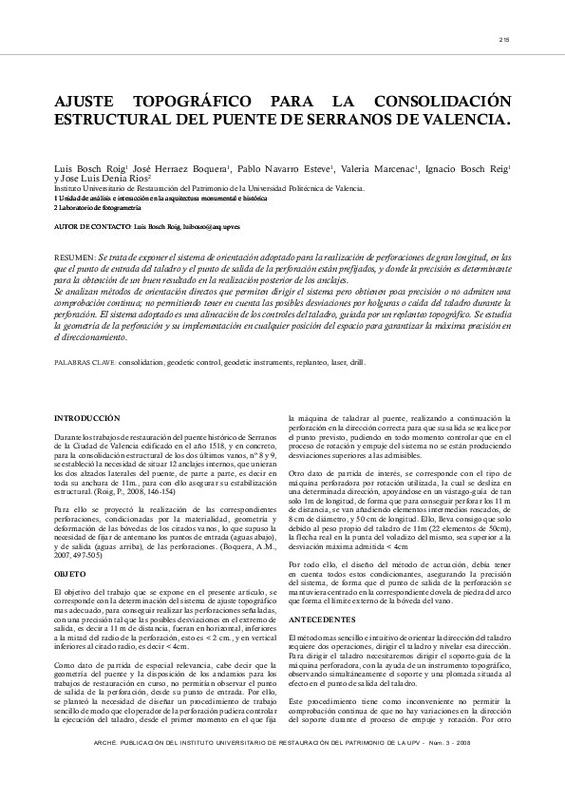JavaScript is disabled for your browser. Some features of this site may not work without it.
Buscar en RiuNet
Listar
Mi cuenta
Estadísticas
Ayuda RiuNet
Admin. UPV
Ajuste topográfico para la consolidación estructural del puente de Serrano de Valencia
Mostrar el registro sencillo del ítem
Ficheros en el ítem
| dc.contributor.author | Bosch Roig, Lluis
|
es_ES |
| dc.contributor.author | Herráez Boquera, José
|
es_ES |
| dc.contributor.author | Navarro Esteve, Pablo José
|
es_ES |
| dc.contributor.author | Marcenac, Valeria
|
es_ES |
| dc.contributor.author | Bosch Reig, Ignacio
|
es_ES |
| dc.contributor.author | Denia Ríos, José Luis
|
es_ES |
| dc.date.accessioned | 2013-09-06T12:46:37Z | |
| dc.date.available | 2013-09-06T12:46:37Z | |
| dc.date.issued | 2008 | |
| dc.identifier.issn | 1887-3960 | |
| dc.identifier.uri | http://hdl.handle.net/10251/31847 | |
| dc.description.abstract | Se trata de exponer el sistema de orientación adoptado para la realización de perforaciones de gran longitud, en las que el punto de entrada del taladro y el punto de salida de la perforación están prefijados, y donde la precisión es determinante para la obtención de un buen resultado en la realización posterior de los anclajes. Se analizan métodos de orientación directos que permiten dirigir el sistema pero obtienen poca precisión o no admiten una comprobación continua; no permitiendo tener en cuenta las posibles desviaciones por holguras o caída del taladro durante la perforación. El sistema adoptado es una alineación de los controles del taladro, guiada por un replanteo topográfico. Se estudia la geometría de la perforación y su implementación en cualquier posición del espacio para garantizar la máxima precisión en el direccionamiento. | es_ES |
| dc.description.abstract | This work presents a system to guide the work of making long perforations whose drill entry points and drill exit points are established, and where accuracy is crucial to obtain a good result for subsequent anchorages. Direct guidance methods that allow a control of the system were analysed. However, they proved poorly accurate or did not make continuous verifications possible, and did not allow possible deviations from the drill becoming loose or falling while drilling to be taken into account. The adopted system is an alignment of the drill controls and the topography of the surfaces is reconsidered. The geometry of the drilling and its implementation in any position of the surface is analysed to ensure maximum accuracy in the drilling direction. | es_ES |
| dc.format.extent | 6 | es_ES |
| dc.language | Español | es_ES |
| dc.publisher | Instituto Universitario de Restauración del Patrimonio de la UPV | es_ES |
| dc.relation.ispartof | Arché | es_ES |
| dc.rights | Reserva de todos los derechos | es_ES |
| dc.subject | Consolidation | es_ES |
| dc.subject | Geodetic control | es_ES |
| dc.subject | Geodetic instruments | es_ES |
| dc.subject | Replanteo | es_ES |
| dc.subject | Laser | es_ES |
| dc.subject | Drill | es_ES |
| dc.subject.classification | CONSERVACION Y RESTAURACION DE BIENES CULTURALES (UPV) | es_ES |
| dc.title | Ajuste topográfico para la consolidación estructural del puente de Serrano de Valencia | es_ES |
| dc.title.alternative | Topographic adjustment for the structural consolidation of the Serrano's bridge of Valencia | es_ES |
| dc.type | Artículo | es_ES |
| dc.rights.accessRights | Abierto | es_ES |
| dc.contributor.affiliation | Universitat Politècnica de València. Instituto Universitario de Restauración del Patrimonio - Institut Universitari de Restauració del Patrimoni | es_ES |
| dc.description.bibliographicCitation | Bosch Roig, L.; Herráez Boquera, J.; Navarro Esteve, PJ.; Marcenac, V.; Bosch Reig, I.; Denia Ríos, JL. (2008). Ajuste topográfico para la consolidación estructural del puente de Serrano de Valencia. Arché. (3):215-220. http://hdl.handle.net/10251/31847 | es_ES |
| dc.description.upvformatpinicio | 215 | es_ES |
| dc.description.upvformatpfin | 220 | es_ES |
| dc.description.issue | 3 | es_ES |
| dc.identifier.eissn | 2445-1150 |
Este ítem aparece en la(s) siguiente(s) colección(ones)
-
Arché - Nº 03 : 2008 [45]






